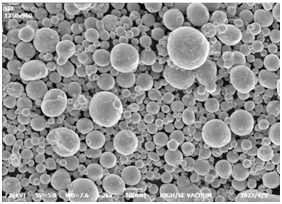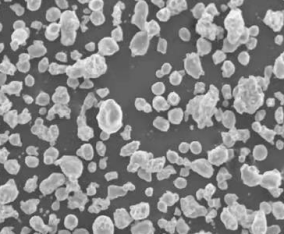CuAlNi powder, a unique alloy comprising copper (Cu), aluminum (Al), and nickel (Ni), is widely recognized for its impressive mechanical properties, shape memory effect, and corrosion resistance. This versatile material has found applications in industries ranging from aerospace to biomedical. In this detailed guide, we will explore the composition, characteristics, uses, advantages, and limitations of CuAlNi powder. We’ll also present specific metal powder models, delve into detailed specifications, and offer a comprehensive FAQ section to answer common questions.
Overview of CuAlNi Powder
CuAlNi powder is a copper-based alloy powder that leverages the unique synergy of its components to deliver a material with exceptional properties. Known for its high-performance attributes, this powder is particularly valued for its shape-memory effect, which allows it to return to its original shape after deformation when exposed to specific temperatures.
Key Features of CuAlNi Powder
- Composition: Predominantly copper with carefully controlled proportions of aluminum and nickel.
- Applications: Used in actuators, sensors, biomedical devices, aerospace components, and more.
- Properties: Excellent thermal and electrical conductivity, corrosion resistance, and wear resistance.
- Form: Typically available as fine powders with uniform particle sizes for precise applications.

Types and Specific Models of CuAlNi Powder
Here’s a closer look at specific CuAlNi powder models, their composition, and applications:
| Model Name | Composition | Particle Size | Applications |
|---|---|---|---|
| CuAlNi-10-20 | Cu (80%), Al (10%), Ni (10%) | 10–20 microns | Shape-memory actuators and switches |
| CuAlNi-15-10 | Cu (75%), Al (15%), Ni (10%) | 15–25 microns | Aerospace components, turbine blades |
| CuAlNi-20-15 | Cu (70%), Al (20%), Ni (10%) | 20–30 microns | Precision biomedical implants |
| CuAlNi-12-12 | Cu (76%), Al (12%), Ni (12%) | 5–15 microns | Microelectronic sensors |
| CuAlNi-Fine30 | Cu (78%), Al (12%), Ni (10%) | <10 microns | High-precision welding and soldering |
| CuAlNi-Coarse50 | Cu (75%), Al (15%), Ni (10%) | 30–50 microns | Structural components, industrial bearings |
| CuAlNi-Super20 | Cu (72%), Al (18%), Ni (10%) | 10–20 microns | Smart materials in robotics |
| CuAlNi-Nano | Cu (80%), Al (10%), Ni (10%) | <1 micron | Advanced nanotechnology applications |
| CuAlNi-BioMed | Cu (75%), Al (15%), Ni (10%) | 10–15 microns | Biocompatible implants |
| CuAlNi-HighTemp | Cu (78%), Al (12%), Ni (10%) | 20–40 microns | High-temperature furnace components |
Composition of CuAlNi Powder
The composition of CuAlNi powder significantly influences its physical and mechanical properties. Let’s break it down:
| Element | Percentage (%) | Function |
|---|---|---|
| Copper (Cu) | 70–80 | Provides base structure and conductivity |
| Aluminum (Al) | 10–20 | Enhances strength and corrosion resistance |
| Nickel (Ni) | 10–15 | Introduces shape-memory properties |
Variations
The specific ratios of aluminum and nickel are adjusted based on the desired characteristics, such as higher shape-memory functionality or improved resistance to extreme conditions.
Properties and Characteristics of CuAlNi Powder
CuAlNi powder is known for its diverse range of properties, making it suitable for demanding applications.
| Property | Description |
|---|---|
| Shape-memory effect | Returns to original shape after deformation when heated |
| Corrosion resistance | Performs well in harsh environments, including marine settings |
| Thermal conductivity | Excellent heat transfer properties |
| Electrical conductivity | Efficient electrical performance |
| Mechanical strength | High tensile strength and durability |
| Wear resistance | Superior resistance to abrasion and wear |
| Machinability | Easily processed and molded into complex shapes |






Applications of CuAlNi Powder
CuAlNi powder is a versatile material with applications across multiple industries.
| Industry | Application | Benefits |
|---|---|---|
| Aerospace | Actuators, turbine blades | Lightweight, high strength |
| Biomedical | Implants, surgical tools | Biocompatibility, shape-memory properties |
| Electronics | Sensors, connectors | High conductivity, precise performance |
| Automotive | Engine components, gears | Wear resistance, durability |
| Robotics | Smart materials for movement systems | Shape-memory effect, reliability |
| Marine | Corrosion-resistant components | Long lifespan in saline environments |
Specifications, Sizes, and Standards
The table below summarizes the key specifications for CuAlNi powders:
| Specification | Details |
|---|---|
| Particle size range | Nano (<1 micron) to coarse (30–50 microns) |
| Purity | 99.9% |
| Packaging | Sealed bags, vacuum containers |
| Standards | ISO 9001, ASTM B88 |
Suppliers and Pricing Details
Here are some popular suppliers and indicative pricing:
| Supplier | Region | Price Range (USD/kg) | Special Features |
|---|---|---|---|
| PowderTech Metals | North America | $80–120 | Customizable particle sizes |
| AlNi Solutions | Europe | $90–140 | Biocompatible grades available |
| Global Alloy Powders | Asia | $70–100 | High volume discounts |

Comparing Advantages and Limitations
| Aspect | Advantages | Limitations |
|---|---|---|
| Cost | Affordable compared to alternative alloys | Slightly higher than pure metal powders |
| Versatility | Wide range of applications | Limited supply of niche grades |
| Shape-memory effect | Unique property not found in many materials | Requires precise temperature control |
FAQ
| Question | Answer |
|---|---|
| What is CuAlNi powder used for? | Applications include actuators, sensors, implants, and turbines. |
| How does the shape-memory effect work? | The material returns to its original shape upon heating. |
| Is CuAlNi powder expensive? | Prices range from $70–$140 per kg depending on grade and purity. |
| Can CuAlNi be used in marine environments? | Yes, its corrosion resistance makes it suitable for such settings. |
| What are its main properties? | Corrosion resistance, strength, and shape-memory characteristics. |

